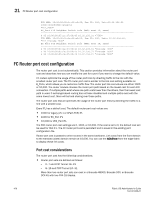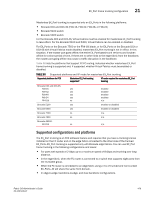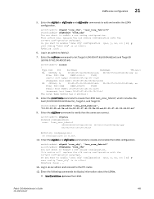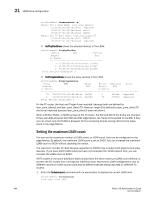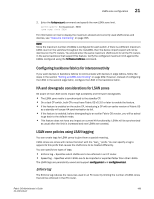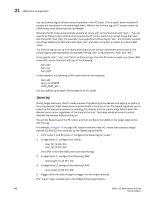HP StorageWorks 1606 Brocade Fabric OS Administrator's Guide v6.3.0 (53-100133 - Page 523
LSAN zone configuration, Use of Admin Domains with LSAN zones and FCR, Zone definition and naming - extension san base switch
 |
View all HP StorageWorks 1606 manuals
Add to My Manuals
Save this manual to your list of manuals |
Page 523 highlights
LSAN zone configuration 21 20 2 4 ee1400 id N4 21 2 5 ee1500 id N4 22 2 6 ee1600 id N4 23 2 7 ee1700 id N4 (fabric id = 2 )(Trunk master) Online Online Online Online EX_Port EX_Port EX_Port EX_Port (Trunk port, master is Slot 2 Port 7 ) (Trunk port, master is Slot 2 Port 7 ) (Trunk port, master is Slot 2 Port 7 ) 10:00:00:60:69:80:1d:bc "MtOlympus_72" LSAN zone configuration An LSAN consists of zones in two or more edge or backbone fabrics that contain the same devices. LSANs essentially provide selective device connectivity between fabrics without forcing you to merge those fabrics. FC routers provide multiple mechanisms to manage interfabric device connectivity through extensions to existing switch management interfaces. You can define and manage LSANs using Brocade Advanced Zoning. Use of Admin Domains with LSAN zones and FCR You can create LSAN zones as a physical fabric administrator or as an individual Admin Domain (AD) administrator. The LSAN zone can be part of the root zone database or the AD zone database. FCR harvests the LSAN zones from all administrative domains. If both edge fabrics have the matching LSAN zones and both devices are online, FCR triggers a device import. To support legacy applications, WWNs are reported based on the administrative domain context. As a result, you must not use the network address authority (NAA) field in the WWN to detect an FC router. LSAN zone enforcement in the local fabric occurs only if the administration domain member list contains both of the devices (local and imported device) specified in the LSAN zone. For more information, see Chapter 15, "Managing Administrative Domains". Zone definition and naming Zones are defined locally on a switch or director. Names and memberships, with the exception of hosts and targets exported from one fabric to another, do not need to be coordinated with other fabrics. For example, in Figure 72 on page 464, when the zones for Edge SAN 1 are defined, you do not need to consider the zones in Edge SAN 2, and vice versa. Zones that contain hosts and targets that are shared between the two fabrics need to be explicitly coordinated. To share devices between any two fabrics, you must create an LSAN zone in both fabrics containing the port WWNs of the devices to be shared. Although an LSAN is managed using the same tools as any other zone on the edge fabric, two behaviors distinguish an LSAN from a conventional zone: • A required naming convention. The name of an LSAN begins with the prefix "LSAN_". The LSAN name is case-insensitive; for example, lsan_ is equivalent to LSAN_, Lsan_, and so on. • Members must be identified by their port WWN because port IDs are not necessarily unique across fabrics. The names of the zones need not be explicitly the same, and membership lists of the zones need not be in the same order. NOTE The "LSAN_" prefix must appear at the beginning of the zone name. LSAN zones may not be combined with QoS zones. See "QoS zones" on page 416 for more information about the naming convention for QoS zones. Fabric OS Administrator's Guide 481 53-1001336-01



